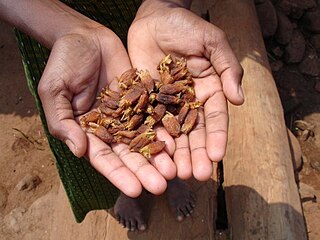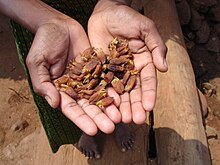
Odisha, formerly Orissa, is an Indian state located in Eastern India. It is the 8th largest state by area, and the 11th largest by population. The state has the third largest population of Scheduled Tribes in India. It neighbours the states of West Bengal and Jharkhand to the north, Chhattisgarh to the west, Andhra Pradesh to the south. Odisha has a coastline of 485 kilometres (301 mi) along the Bay of Bengal. The region is also known as Utkala and is mentioned in India's national anthem, "Jana Gana Mana". The language of Odisha is Odia, which is one of the Classical Languages of India. The ancient kingdom of Kalinga, which was invaded by the Mauryan Emperor Ashoka in 261 BCE resulting in the Kalinga War, coincides with the borders of modern-day Odisha. The modern boundaries of Odisha were demarcated by the British Indian government when Orissa Province was established on 1 April 1936, consisting of the Odia-speaking districts of Bihar and Orissa Province. The first of April is celebrated as Utkala Dibasa. Cuttack was made the capital of the region by Anantavarman Chodaganga in c. 1135, after which the city was used as the capital by many rulers, through the British era until 1948. Thereafter, Bhubaneswar became the capital of Odisha. The economy of Odisha is the 16th-largest state economy in India with ₹5.86 trillion (US$77 billion) in gross domestic product and a per capita GDP of ₹127,383 (US$1,700). Odisha ranks 32nd among Indian states in Human Development Index.

Shorea robusta, the sal tree, sāla, shala, sakhua, or sarai, is a species of tree in the family Dipterocarpaceae.

Agarwood, aloeswood, eaglewood or gharuwood is a fragrant dark resinous wood used in incense, perfume, and small carvings. It is formed in the heartwood of aquilaria trees when they become infected with a type of mold. Prior to infection, the heartwood is odourless, relatively light and pale coloured; however, as the infection progresses, the tree produces a dark aromatic resin, called aloes or agar as well as gaharu, jinko, oud, or oodhaguru, in response to the attack, which results in a very dense, dark, resin-embedded heartwood. The resin-embedded wood is valued in East and South Asian cultures for its distinctive fragrance, and thus is used for incense and perfumes.

Kandhamal district is a district in the state of Odisha, India. The district headquarters of the district is Phulbani. Kandhamal is famous for its local turmeric renowned as 'Kandhamal Haldi' which has earned the Geographical indication (GI) tag from Intellectual Property India, an organisation functioning under the auspices of the Ministry of Commerce and Industry (India). It is the district full with natural beauties includes wild animals and birds.

Diospyros melanoxylon, the Coromandel ebony or East Indian ebony, is a species of flowering tree in the family Ebenaceae native to India and Sri Lanka; it has a hard, dry bark. Its common name derives from Coromandel, the coast of southeastern India. Locally it is known as temburini or by its Hindi name tendu. In Odisha, Jharkhand, and Assam, it is known as kendu. The leaves can be wrapped around tobacco to create the Indian beedi, which has outsold conventional cigarettes in India. The olive-green fruit of the tree is edible

The Eastern Highlands moist deciduous forests, presently known as East Deccan moist deciduous forests, is a tropical and subtropical moist broadleaf forests ecoregion in east-central India. The ecoregion covers an area of 341,100 square kilometers (131,700 sq mi), extending across portions of Andhra Pradesh, Chhattisgarh, Jharkhand, Madhya Pradesh, Maharashtra, Odisha, and Telangana states.

Non-timber forest products (NTFPs) are useful foods, substances, materials and/or commodities obtained from forests other than timber. Harvest ranges from wild collection to farming. They typically include game animals, fur-bearers, nuts, seeds, berries, mushrooms, oils, sap, foliage, pollarding, medicinal plants, peat, mast, fuelwood, fish, insects, spices, and forage. Overlapping concepts include non-wood forest products (NWFPs), wild forest products, minor forest produce, special, minor, alternative and secondary forest products – for further distinctions see the definition section below
Forest farming is the cultivation of high-value specialty crops under a forest canopy that is intentionally modified or maintained to provide shade levels and habitat that favor growth and enhance production levels. Forest farming encompasses a range of cultivated systems from introducing plants into the understory of a timber stand to modifying forest stands to enhance the marketability and sustainable production of existing plants.

Vateria indica, the white dammar, is a species of tree in the family Dipterocarpaceae. It is endemic to the Western Ghats mountains in India. It is threatened by habitat loss. It is a large canopy or emergent tree frequent in tropical wet evergreen forests of the low and mid-elevations.
The College of Forestry (CFOR), Dapoli, established on 1 August 2005, is a constituent college of Dr. Balasaheb Sawant Konkan Krishi Vidyapeeth, located on the main campus in Dapoli, Ratnagiri district, Maharashtra.

Odisha, a state in eastern India, is extremely diverse and gives the state abundance of natural beauty and wildlife. The districts in the interior are thickly covered by tropical moist deciduous and tropical dry deciduous forests. The hills, plateaus and isolated areas of the northeastern part of the state are covered by the tropical moist deciduous forests whereas the dry deciduous forests are located in the southwest region of the state. Some of the trees which grow in abundance in Odisha are bamboo, teak, rosewood, sal, piasal, sanghvan and haldi. There are 479 species of birds, 86 species of mammals, 19 species of amphibians and 110 species of reptiles present in Odisha. The state is also an important habitat for the endangered olive ridley turtles and Irrawaddy dolphins. Koraput district of southern Odisha has been identified by Food and Agriculture Organisation (FAO) of UN as Global Agricultural Heritage site which is among only other three sites in the world. Other sites are in Peru, China and Philippines.

Chandaka Elephant Sanctuary is a wildlife reserve located in the south fringe of cuttack in the Indian state of Odisha. Nestled on Khurdha uplands of the Eastern Ghats biotic region, Chandaka forest is spread over 175.79 square kilometres (67.87 sq mi) of rolling table land and small sprawling hillocks of Khurdha and Cuttack Districts. It was designated as an elephant reserve in December 1982.

Shorea robusta seed oil is an edible oil extracted from the seeds of Shorea robusta. Shorea robusta is known as the Sal tree in India. Sal is indigenous to India and occurs in two main regions separated by the Gangetic Plain, namely the northern and central Indian regions. The plant belongs to the Dipterocarpaceae botanical family.
Pingua is a village in Dhenkanal district, Odisha, India.

The Balukhand-Konark Wildlife Sanctuary is a wildlife sanctuary located in the Indian state of Odisha.
Hendua is an Indian cuisine of Western Odisha that is normally consumed as pickle or seasoning, garnishing as a liquor when fermented and eaten with roasted or fried tomatoes. Hendua is hard-sundried or pickled bamboo shoot that is eaten alone and also by adding with other dishes, both fresh and stored as pickle. New sprouts of bamboo culms that are procured from bamboo-forests by locals are sliced and pickled. They are fried to prepare the dish. Many locals and indigenous people generally use hendua for making curries. Hendua is generally produced in households and sold in village haats.
Centre for People's Forestry is a civil society organisation in India, established in August 2002. CPF works for the rights and livelihoods of forest-dependent communities with due regard to conservation. It believes that the claim to conservation, control and management of the forest resources belong to the forest-dwelling and dependent communities and their livelihoods should be the primary concern of all forestry programmes.
The Sheka Forest is a UNESCO designated Biosphere Reserve in south western Ethiopia. The area includes forest, bamboo thickets, wetlands, agricultural land, rural settlements and towns. It covers a unique biogeographic unit extending from cold and very wet highlands to hot lowland areas. The diverse resident human population is committed to sustainable use of the forests through both the production of wooden items and non-timber forest products. It was declared in 2012 and is administered by SNNP Region Bureau of Agriculture, Sheka Zone Administration, Sheka Zone Department of Agriculture, Masha Woreda Office of Agriculture, Anderacha Woreda Office of Agriculture, Yeski Woreda Office of Agriculture. The reserve covers a core area of 238,750 hectares, with a buffer zone 76,395 hectares and transition areas of 107,100 hectares.
The Kuldiha Wildlife Sanctuary is situated in the Balasore district of Odisha, India. The sanctuary is spread across 272.75 km2 (105 sq mi) in the Chota Nagpur Plateau region. It is linked with Simlipal National Park via the Sukhupada and Nato hill ranges. It is classified as an Eastern Highlands moist deciduous forests ecoregion.
Kotgarh Wildlife Sanctuary is situated in the Baliguda subdivision of Kandhamal district of Odisha state in India. It is classified as an Eastern Highlands moist deciduous forest. Around 52 tribal villages such as Kutia Kondh and Desia Kondh inhabit the sanctuary.














